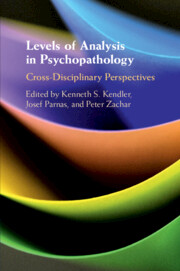Book contents
- Levels of Analysis in Psychopathology
- Advance Praise for Levels of Analysis in Psychopathology
- Levels of Analysis in Psychopathology
- Copyright page
- Contents
- Figures
- Tables
- Contributors
- Preface
- General Introduction
- Part I Neuroscience, Mechanisms, and RDoC
- Section 1
- Section 2
- Section 3
- 7 Introduction
- 8 Tackling Hard Problems: Neuroscience, Treatment, and Anxiety
- 9 Commentary on Daniel S. Pine
- Part II Phenomenology, Biological Psychology, and the Mind–Body Problem
- Part III Taxonomy, Integration, and Multiple Levels of Explanation
- Index
- References
8 - Tackling Hard Problems: Neuroscience, Treatment, and Anxiety
from Section 3
Published online by Cambridge University Press: 02 April 2020
- Levels of Analysis in Psychopathology
- Advance Praise for Levels of Analysis in Psychopathology
- Levels of Analysis in Psychopathology
- Copyright page
- Contents
- Figures
- Tables
- Contributors
- Preface
- General Introduction
- Part I Neuroscience, Mechanisms, and RDoC
- Section 1
- Section 2
- Section 3
- 7 Introduction
- 8 Tackling Hard Problems: Neuroscience, Treatment, and Anxiety
- 9 Commentary on Daniel S. Pine
- Part II Phenomenology, Biological Psychology, and the Mind–Body Problem
- Part III Taxonomy, Integration, and Multiple Levels of Explanation
- Index
- References
Summary
This chapter reviews efforts to use neuroscience to inform clinical practice for mental disorders, discussing anxiety disorders as an exemplary foundation for work on other mental illnesses. The chapter unfolds in four stages. The first portion provides an overview, focusing on three levels of inquiry: clinical state; psychological testing; and brain function, as revealed by functional magnetic resonance imaging. Next, the chapter describes research across these three levels for one narrow area of neuroscience, related to the orienting of attention, where progress in clinically relevant domains has been steady. The third section also focuses on the three levels to summarize work on appraisal, a process closely connected to consciousness, where research has yet to profoundly impact clinical thinking.Finally, the chapter concludes by summarizing problems confronting future attempts to establish a clinical neuroscience approach to mental disorders, problems which are difficult to solve due to unique aspects of human thought.
- Type
- Chapter
- Information
- Levels of Analysis in PsychopathologyCross-Disciplinary Perspectives, pp. 91 - 113Publisher: Cambridge University PressPrint publication year: 2020
References
- 1
- Cited by

